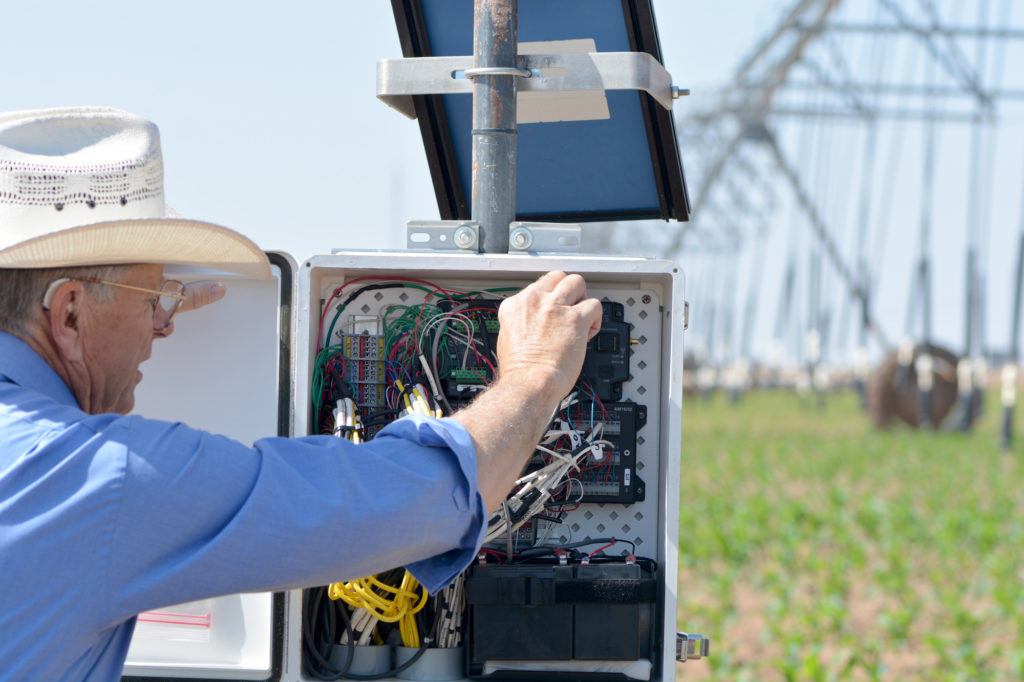Integrating center pivot irrigation control technologies goal of Texas A&M study
Writer: Kay Ledbetter, 806-677-5608, [email protected]
Contacts: Thomas Marek, 806-677-5600, [email protected]
Dr. Dana Porter, 806-723-8426, [email protected]

BUSHLAND – New center pivot irrigation technologies are only beneficial if they are being used, according to a Texas A&M AgriLife Research engineer in Amarillo.
Thomas Marek is leading a team from Texas A&M AgriLife and Texas A&M University to ensure the latest advancements in agricultural irrigation management can be readily integrated for applications in the field.
The team is working to design a system utilizing off-the-shelf sensors and components to create a cost-effective and independent platform that will allow producers to realize benefits of irrigation technologies by integrating and automating information and decision support tools.
Their objectives include establishing:
– A wireless sensor network with anomaly detection.
– An irrigation system controller using real-time and forecast data, integration of data from multiple sensor inputs and unmanned aerial systems, models and safety.
– A user-friendly interface.
The multifaceted project integrates in-field data from multiple sensors and uses machine learning techniques plus crop models to automate irrigation scheduling decisions, Marek said.

Additional faculty members on the project include Dr. Dana Porter, AgriLife Extension engineer, Lubbock; and Dr. Jiang Hu, Texas A&M professor of electrical and computer engineering, College Station, along with three team members in his department, Dr. Justin Sun, Yanxiang Yang and Hongxin Kong.
An accompanying soil water sensor installation and placement study with the project involves Dr. Kevin Heflin, AgriLife Extension program specialist, Amarillo; and Dr. Gary Marek, U.S. Department of Agriculture-Agricultural Research Service research agricultural engineer, Bushland.
“There are some great advanced irrigation technologies available, but they are complex, underutilized, difficult to use and not well integrated in existing control systems, therefore their benefits are not being fully realized,” Porter said.
She said the cooperative and complementary efforts in several research studies at the Bushland research facilities shared by AgriLife Research and USDA-ARS should help change that.
“We had a water seed grant to work on automated, integrated advanced control of a center pivot irrigation system,” Marek said. “We teamed up with Texas A&M’s electrical and computer engineering researchers and worked extensively with them to develop some advanced automation capabilities.”
He said they have already shown significant improvements over commercially available systems by developing a technology suite that includes:
– Improved center pivot irrigation positioning and speed control.
– Improved variable rate irrigation control with real-time updates using in-field near-real-time data plus predictive crop water-use capabilities.
– A soil-moisture in-field sensor placement method to optimize wireless sensor nodes to balance cost with necessary data reliability.
“In our case, advanced automation includes automated communication of data from soil water sensors to the pivot controller,” Marek said.
“We are using a processing model that looks at recent field data and the status today, plus a machine learning process to integrate data and decisions with an automated controller,” he said. “Together this tells the user and the system what to do and when. The system is also unique in that it logs all of what it does, and all of this happens at the pivot.”
Utilizing tools such as real-time soil moisture monitoring, near-real-time and short-term predictive crop evapotranspiration or crop water use, quantitative precipitation forecasting and an artificial intelligence algorithm, he said they are able to automate the “when, where and how much” decisions of crop irrigation.
Development was conducted whereby the platform-independent control system could be retrofitted into existing center pivot irrigation systems. The project team has several patents pending as a result of the work, Marek said, adding this is one of the best research teams he’s worked with in his irrigation career.
Funding and in-kind support for the project was provided by a Texas A&M University System Water Seed Grant, AgriLife Research, AgriLife Extension, Texas A&M Engineering Experiment Station, High Plains Underground Water Conservation District and the USDA-ARS Ogallala Aquifer Program.


